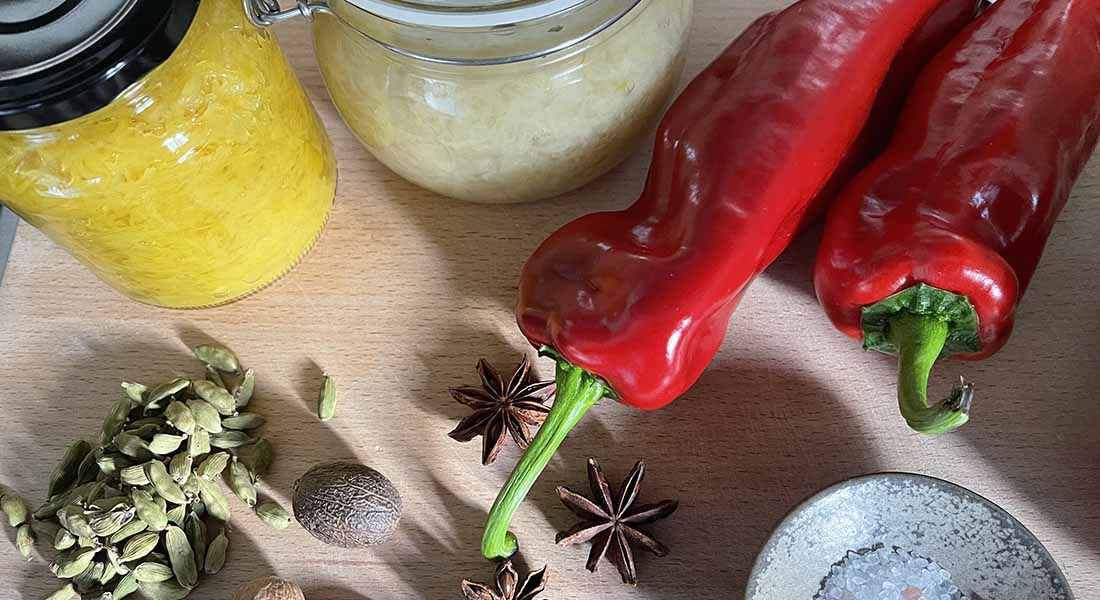Fermentation can help us develop new, green foods
Society can benefit greatly from fermentation as a path towards a more climate-friendly food system if we start researching the fermentation of plants, new raw materials and surplus vegetables, says Professor of Microbial Ecology and Food Fermentation Lene Jespersen from the Department of Food Science at the University of Copenhagen (UCPH FOOD).

“If there is any country that can create a greener food consumption and a greener food industry, it is Denmark,” says Professor of Microbial Ecology and Food Fermentation Lene Jespersen from UCPH FOOD and elaborates:
“In Denmark, we have a very strong food industry and internationally leading manufacturers of starter cultures, which are used for fermentation. We have a long tradition of fermenting animal raw materials in particular, while our tradition of fermenting plants is not quite so well established. That is why we must invest heavily into the research of plant fermentation in the coming decade.”
Development will require that we gain a more in-depth understanding of the ability of microorganisms to reproduce in plant-based raw materials, how they interact with each other and not least that we understand their ability to transform raw materials into edible, tasty and healthy products with a long shelf life.
Plenty of potential variety
“If we go back ten years, there has been a rapid development in fermentation and many consumers now know that microorganisms can be used to achieve improved foods. An entire forest of microbreweries has emerged; many chefs have made fermentation a theme and contributed to it becoming trendy. Fermentation has brought a lot of innovation into food production and we must develop this even more in the future,” explains Lene Jespersen.
Fermentation can help us with many of the challenges we face when we want to eat a more plant-based diet.
“It is, for example, a challenge to give plants a more complex taste as well as to create structures in the food that appeal to consumers, which fermentation can contribute to,” explains Lene Jespersen.
In addition, fermentation can help with some nutritional challenges, as the fermentation process can create different vitamins and increase the availability of minerals. Fermentation can also help to preserve the diversity of our cooking and meals, even if we have to limit the use of animal and animal-based products.
“If society encourages consumers to switch to a more plant-based diet, we also have an obligation to offer a certain variety of tasty and healthy foods, which we also have for other food groups. Here too, fermentation can help, as you can create many different tastes and structures using fermentation and thus introduce new varieties of products and completely new product types,” says Lene Jespersen.
The endless taste conductor
During fermentation, the microorganisms basically convert the substances in a given raw material into metabolites, which provides a specific taste profile depending on which raw materials and which microorganisms are involved.
“Different groups of microorganisms can produce different types of flavours; for example, brewer’s yeast is good for creating the fruity flavour notes we find in beer, while the bacteria Bacillus subtilis is good at breaking down proteins and forming amino acids, which help to give the coveted umami taste that is reminiscent of meat. The more types of microorganisms you use: yeast, bacteria – including the well-known lactic acid bacteria – or molds, the more different types of flavour components you can get in different types of food,” explains Lene Jespersen, emphasising that not all microorganisms can be used in all raw materials.
Microorganisms are unique in producing flavours. For example, in a non-fermented beverage such as a soft drink, there are 10-20 flavour components, while a beer, which is a fermented beverage, has more than 400 different flavour components.
Inedible plants become edible
Fermentation can also be used to make inedible plants edible.
“It is conceivable that in the future we will be able to ferment, for example, that excess vegetables so that they can be made edible or that we can actively use fermentation as a green processing technology to minimise energy consumption, e.g. by industrially fermenting raw materials and thus skipping some energy-intensive steps. In households, you can ferment dried beans, for example, instead of cooking them for a long time. In general, we must research how to let the microorganisms’ enzymes do the work that is normally very energy-intensive and make inedible raw materials edible,” says Lene Jespersen.
More private fermentation
As it is today, a lot of vegetables are thrown out by households, simply because they have become overripe and Lene Jespersen predicts that in the coming years we will get better at fermenting our own household plant waste.
“You can imagine buying small kits for home fermentation. When the vegetables get past their prime, you might add a powder with good lactic acid bacteria and create a product that can be used as a kind of pickles. This can be further developed with indicators for food safety, apps etc. Consumers are already interested in fermenting their own vegetables and I think we will see much more of it,” explains Lene Jespersen.
Topics
Related News
Contact
Professor Lene Jespersen, Department of Food Science at the University of Copenhagen (UCPH FOOD), lj@food.ku.dk
Or
Communications Officer at UCPH FOOD Lene Hundborg Koss, lene.h.koss@food.ku.dk
